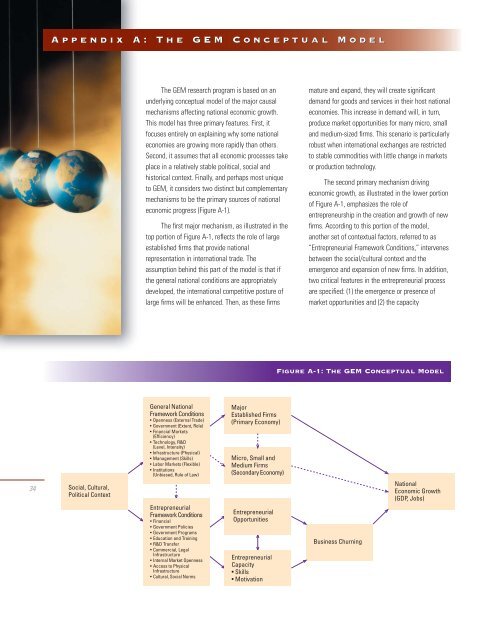Global entrepreneurship report - ResearchGate
Global entrepreneurship report - ResearchGate
Global entrepreneurship report - ResearchGate
Create successful ePaper yourself
Turn your PDF publications into a flip-book with our unique Google optimized e-Paper software.
Appendix A: The GEM Conceptual Model<br />
The GEM research program is based on an<br />
underlying conceptual model of the major causal<br />
mechanisms affecting national economic growth.<br />
This model has three primary features. First, it<br />
focuses entirely on explaining why some national<br />
economies are growing more rapidly than others.<br />
Second, it assumes that all economic processes take<br />
place in a relatively stable political, social and<br />
historical context. Finally, and perhaps most unique<br />
to GEM, it considers two distinct but complementary<br />
mechanisms to be the primary sources of national<br />
economic progress (Figure A-1).<br />
The first major mechanism, as illustrated in the<br />
top portion of Figure A-1, reflects the role of large<br />
established firms that provide national<br />
representation in international trade. The<br />
assumption behind this part of the model is that if<br />
the general national conditions are appropriately<br />
developed, the international competitive posture of<br />
large firms will be enhanced. Then, as these firms<br />
mature and expand, they will create significant<br />
demand for goods and services in their host national<br />
economies. This increase in demand will, in turn,<br />
produce market opportunities for many micro, small<br />
and medium-sized firms. This scenario is particularly<br />
robust when international exchanges are restricted<br />
to stable commodities with little change in markets<br />
or production technology.<br />
The second primary mechanism driving<br />
economic growth, as illustrated in the lower portion<br />
of Figure A-1, emphasizes the role of<br />
<strong>entrepreneurship</strong> in the creation and growth of new<br />
firms. According to this portion of the model,<br />
another set of contextual factors, referred to as<br />
“Entrepreneurial Framework Conditions,” intervenes<br />
between the social/cultural context and the<br />
emergence and expansion of new firms. In addition,<br />
two critical features in the entrepreneurial process<br />
are specified: (1) the emergence or presence of<br />
market opportunities and (2) the capacity<br />
Figure A-1: The GEM Conceptual Model<br />
General National<br />
Framework Conditions<br />
• Openness (External Trade)<br />
•Government (Extent, Role)<br />
• Financial Markets<br />
(Efficiency)<br />
•Technology, R&D<br />
(Level, Intensity)<br />
• Infrastructure (Physical)<br />
•Management (Skills)<br />
• Labor Markets (Flexible)<br />
• Institutions<br />
(Unbiased, Rule of Law)<br />
Major<br />
Established Firms<br />
(Primary Economy)<br />
Micro, Small and<br />
Medium Firms<br />
(Secondary Economy)<br />
34<br />
Social, Cultural,<br />
Political Context<br />
Entrepreneurial<br />
Framework Conditions<br />
• Financial<br />
•Government Policies<br />
•Government Programs<br />
• Education and Training<br />
• R&D Transfer<br />
• Commercial, Legal<br />
Infrastructure<br />
•Internal Market Openness<br />
• Access to Physical<br />
Infrastructure<br />
• Cultural, Social Norms<br />
Entrepreneurial<br />
Opportunities<br />
Entrepreneurial<br />
Capacity<br />
• Skills<br />
• Motivation<br />
Business Churning<br />
National<br />
Economic Growth<br />
(GDP, Jobs)
















